

Compact Muon Solenoid
LHC, CERN
| CMS-EXO-13-006 ; CERN-PH-EP-2015-014 | ||
| Constraints on the pMSSM, AMSB model and on other models from the search for long-lived charged particles in proton-proton collisions at $\sqrt{s}$ = 8 TeV | ||
| CMS Collaboration | ||
| 9 February 2015 | ||
| Eur. Phys. J. C 75 (2015) 325 | ||
| Abstract: Stringent limits are set on the long-lived lepton-like sector of the phenomenological minimal supersymmetric standard model (pMSSM) and the anomaly-mediated supersymmetry breaking (AMSB) model. The limits are derived from the results presented in a recent search for long-lived charged particles in proton-proton collisions, based on data collected by the CMS detector at a centre-of-mass energy of 8 TeV at the Large Hadron Collider. In the pMSSM parameter sub-space considered, 95.9% of the points predicting charginos with a lifetime of at least 10 ns are excluded. These constraints on the pMSSM are the first obtained at the LHC. Charginos with a lifetime greater than 100 ns and masses up to about 800 GeV in the AMSB model are also excluded. The method described can also be used to set constraints on other models. | ||
| Links: e-print arXiv:1502.02522 [hep-ex] (PDF) ; CDS record ; inSPIRE record ; Public twiki page ; HepData record ; CADI line (restricted) ; | ||
| Figures | |
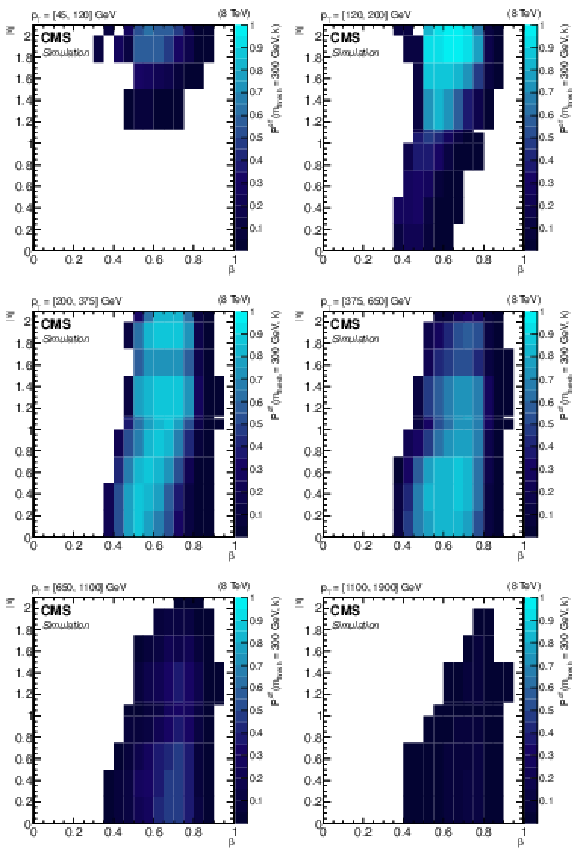
png pdf |
Figure 1:
Signal acceptance as a function of the chargino lifetime for a benchmark model having a chargino of mass 100 GeV (a) and 700 GeV (b), with a mass threshold of 0 GeV and 300 GeV, respectively. The panel below each figure shows the ratio of acceptance from the fast technique to the acceptance obtained from a full simulation of the detector. |
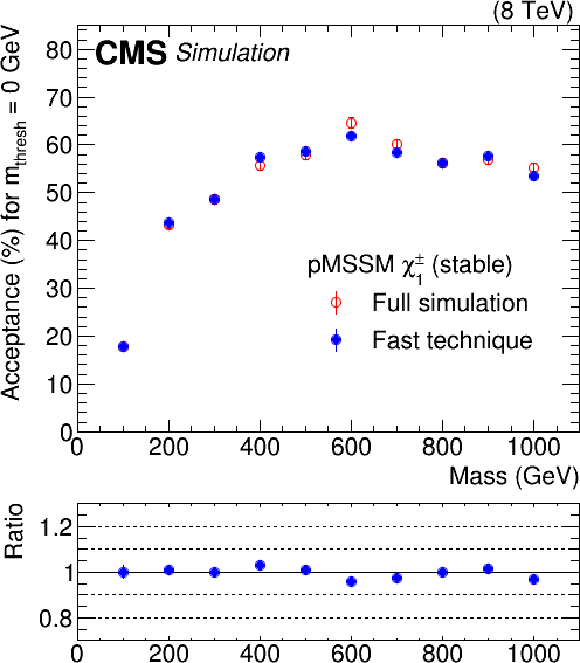
png |
Figure 1-a:
Signal acceptance as a function of the chargino lifetime for a benchmark model having a chargino of mass 100 GeV (a) and 700 GeV (b), with a mass threshold of 0 GeV and 300 GeV, respectively. The panel below each figure shows the ratio of acceptance from the fast technique to the acceptance obtained from a full simulation of the detector. |
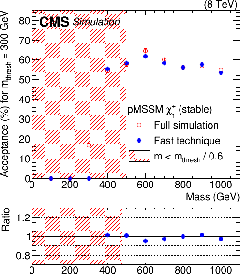
png |
Figure 1-b:
Signal acceptance as a function of the chargino lifetime for a benchmark model having a chargino of mass 100 GeV (a) and 700 GeV (b), with a mass threshold of 0 GeV and 300 GeV, respectively. The panel below each figure shows the ratio of acceptance from the fast technique to the acceptance obtained from a full simulation of the detector. |
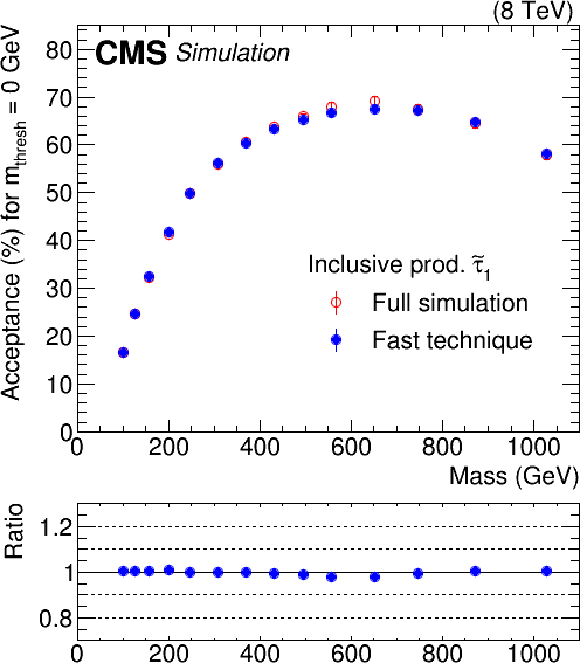
png |
Figure 1-c:
Signal acceptance as a function of the chargino lifetime for a benchmark model having a chargino of mass 100 GeV (a) and 700 GeV (b), with a mass threshold of 0 GeV and 300 GeV, respectively. The panel below each figure shows the ratio of acceptance from the fast technique to the acceptance obtained from a full simulation of the detector. |
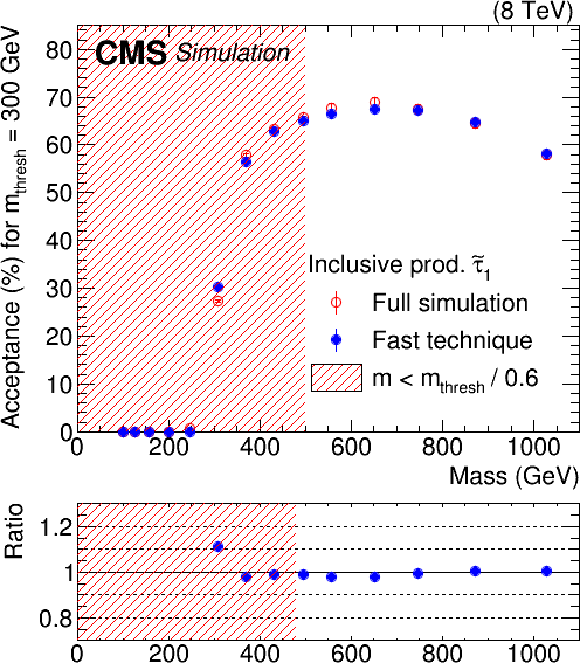
png |
Figure 1-d:
Signal acceptance as a function of the chargino lifetime for a benchmark model having a chargino of mass 100 GeV (a) and 700 GeV (b), with a mass threshold of 0 GeV and 300 GeV, respectively. The panel below each figure shows the ratio of acceptance from the fast technique to the acceptance obtained from a full simulation of the detector. |

png pdf |
Figure 2-a:
Signal acceptance as a function of the chargino production mechanism for a benchmark model having a chargino of mass 200 GeV (a) and 700 GeV (b), with a mass threshold of 100 GeV and 300 GeV, respectively. From left to right, the production mechanisms considered are: direct pair production of charginos; pair production of gluinos that each decay to a heavy quark (b,t) and a chargino; pair production of gluinos that each decay to a light quark (u,d,s,c) and a chargino; and pair production of squarks that each decay to a quark and a chargino. The panel below each figure shows the ratio of acceptance from the fast technique with the isolation requirements to the acceptance obtained from a full simulation of the detector. The estimated acceptance is given with and without the generator-level isolation. Pileup is present only in the full simulation samples. |
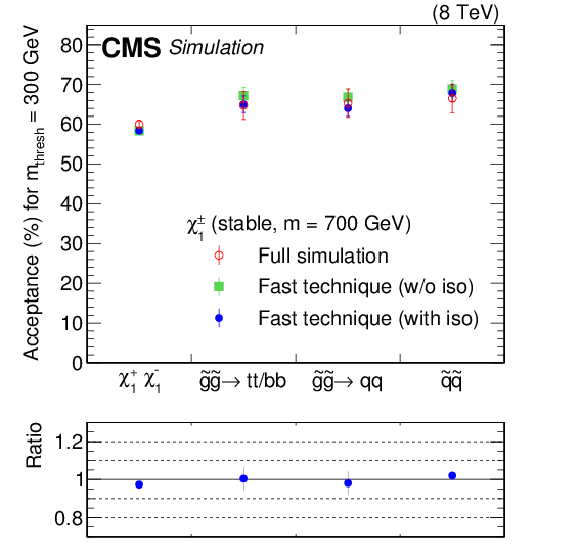
png pdf |
Figure 2-b:
Signal acceptance as a function of the chargino production mechanism for a benchmark model having a chargino of mass 200 GeV (a) and 700 GeV (b), with a mass threshold of 100 GeV and 300 GeV, respectively. From left to right, the production mechanisms considered are: direct pair production of charginos; pair production of gluinos that each decay to a heavy quark (b,t) and a chargino; pair production of gluinos that each decay to a light quark (u,d,s,c) and a chargino; and pair production of squarks that each decay to a quark and a chargino. The panel below each figure shows the ratio of acceptance from the fast technique with the isolation requirements to the acceptance obtained from a full simulation of the detector. The estimated acceptance is given with and without the generator-level isolation. Pileup is present only in the full simulation samples. |
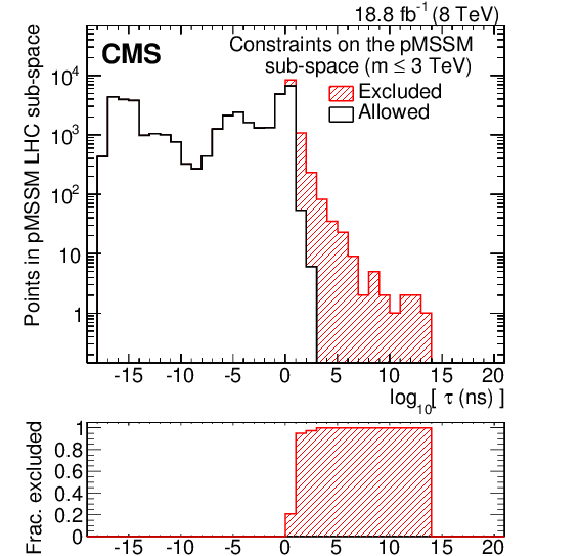
png pdf |
Figure 3-a:
(a) Number of pMSSM points, in the sub-space covering sparticle masses up to about 3 TeV, that are excluded at a 95% CL (hatched red) or allowed (white) as a function of the chargino lifetime. (b) Enlargement of the long-lived region. The bottom panel shows the fraction of pMSSM points excluded by the analysis based on the results from the HSCP search. |
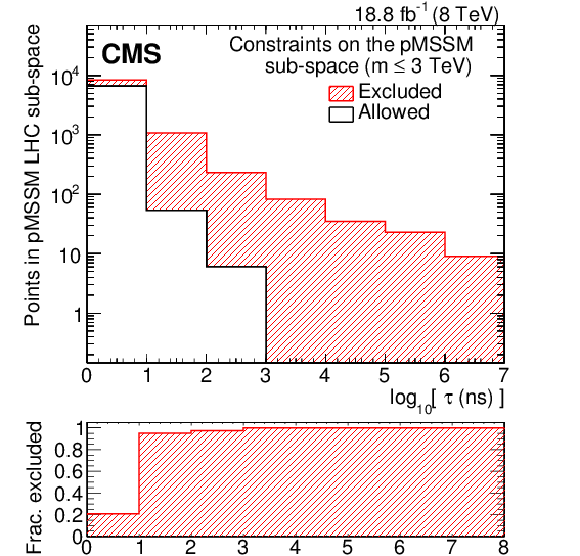
png pdf |
Figure 3-b:
(a) Number of pMSSM points, in the sub-space covering sparticle masses up to about 3 TeV, that are excluded at a 95% CL (hatched red) or allowed (white) as a function of the chargino lifetime. (b) Enlargement of the long-lived region. The bottom panel shows the fraction of pMSSM points excluded by the analysis based on the results from the HSCP search. |
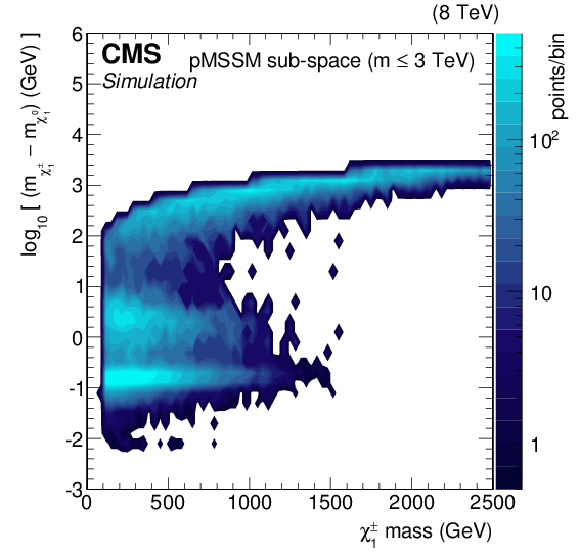
png pdf |
Figure 4-a:
Number of pMSSM parameter points in the sub-space covering sparticle masses up to about 3 TeV shown as a function of the chargino mass and (a,b) of the mass difference between the chargino and the neutralino, and (c,d) chargino lifetime. The (a,c) panels show the entire set of points considered while the (b,d) panels show the set of points excluded by the analysis based on the results from the HSCP search. |
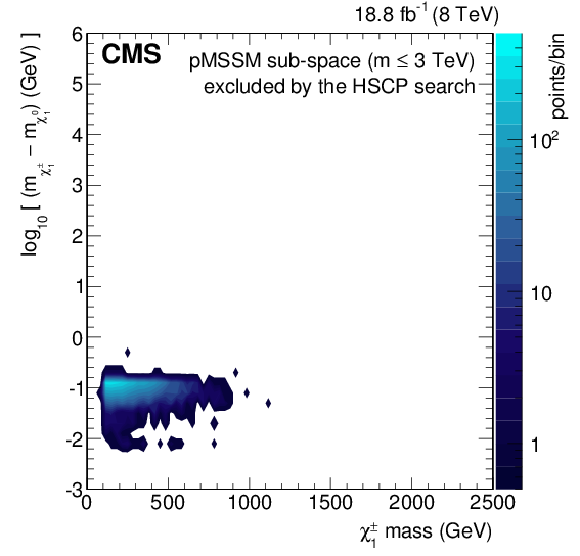
png pdf |
Figure 4-b:
Number of pMSSM parameter points in the sub-space covering sparticle masses up to about 3 TeV shown as a function of the chargino mass and (a,b) of the mass difference between the chargino and the neutralino, and (c,d) chargino lifetime. The (a,c) panels show the entire set of points considered while the (b,d) panels show the set of points excluded by the analysis based on the results from the HSCP search. |

png pdf |
Figure 4-c:
Number of pMSSM parameter points in the sub-space covering sparticle masses up to about 3 TeV shown as a function of the chargino mass and (a,b) of the mass difference between the chargino and the neutralino, and (c,d) chargino lifetime. The (a,c) panels show the entire set of points considered while the (b,d) panels show the set of points excluded by the analysis based on the results from the HSCP search. |
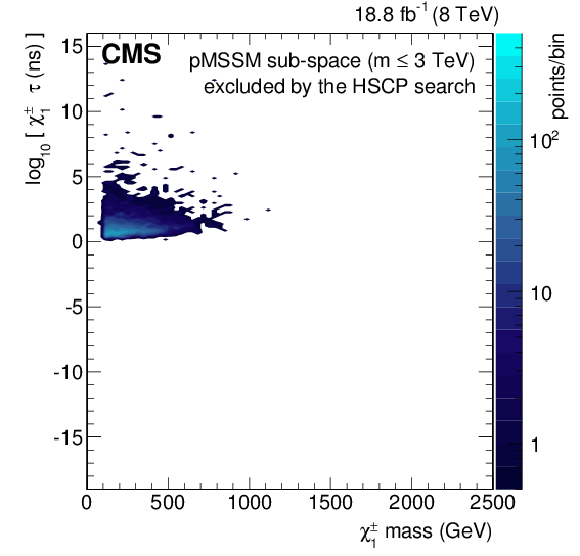
png pdf |
Figure 4-d:
Number of pMSSM parameter points in the sub-space covering sparticle masses up to about 3 TeV shown as a function of the chargino mass and (a,b) of the mass difference between the chargino and the neutralino, and (c,d) chargino lifetime. The (a,c) panels show the entire set of points considered while the (b,d) panels show the set of points excluded by the analysis based on the results from the HSCP search. |
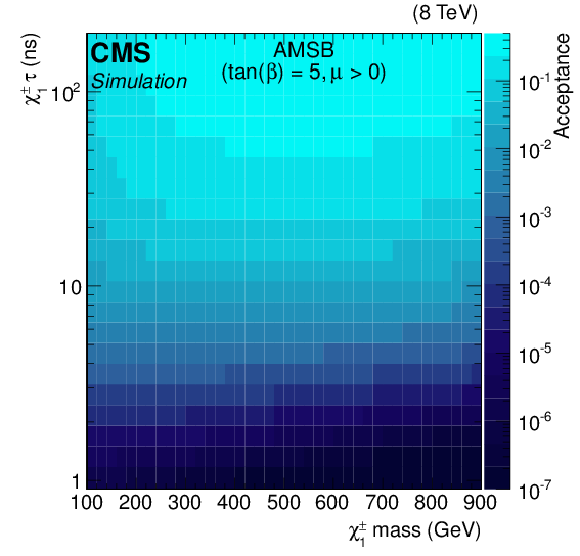
png pdf |
Figure 5-a:
(a) Signal acceptance as a function of chargino mass for the AMSB model as predicted by the fast technique. (b) Observed and expected excluded region on the chargino mass and lifetime parameter space in the context of the AMSB model with $\tan\beta = 5$ and $\mu \ge 0$. The excluded region is indicated by the hatched area. |
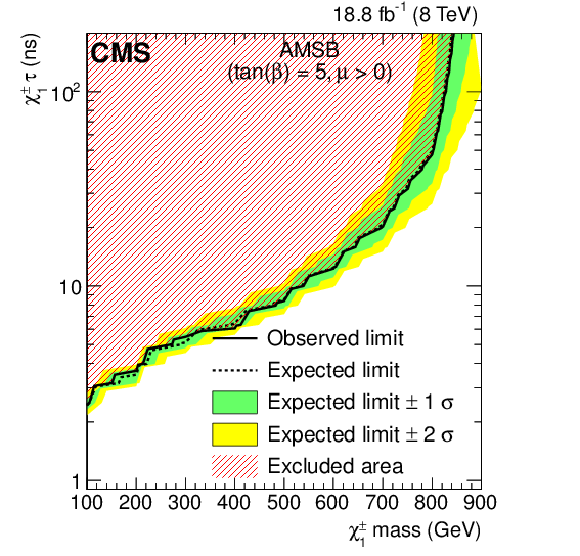
png pdf |
Figure 5-b:
(a) Signal acceptance as a function of chargino mass for the AMSB model as predicted by the fast technique. (b) Observed and expected excluded region on the chargino mass and lifetime parameter space in the context of the AMSB model with $\tan\beta = 5$ and $\mu \ge 0$. The excluded region is indicated by the hatched area. |
| Tables | |

png pdf |
Table 1:
Summary of the information needed to set limits on a signal model predicting lepton-like charged long-lived particles. The mass threshold, the corresponding expected background, and the observed numbers of events, as well as the uncertainty in the signal acceptance evaluated with the fast technique, are provided as a function of the long-lived particle mass. |
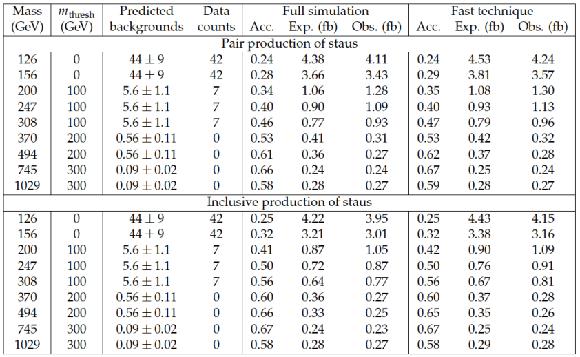
png pdf |
Table 2:
Signal acceptance estimated from the fast technique and with the full simulation of the detector, as well as the corresponding expected and observed cross section limits. Results are provided for both the pair production and the inclusive production of staus as predicted by the GMSB model. The mass threshold, the corresponding expected background and the observed numbers of events is also shown. |
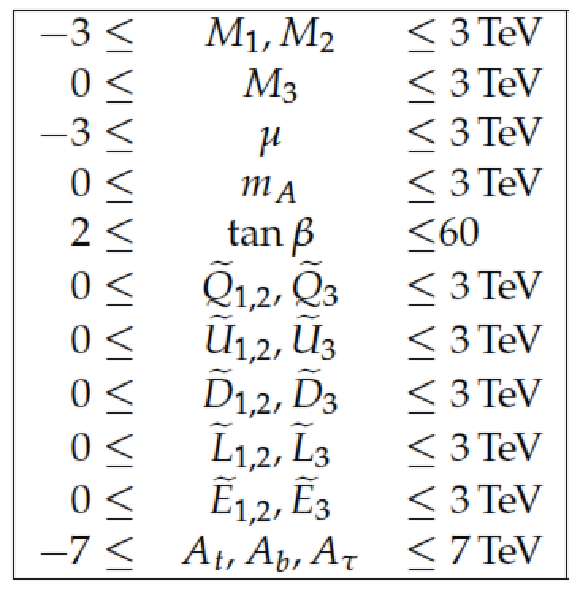
png pdf |
Table 3:
The pMSSM parameter space used in the scan. |
| Summary |
| The results of the CMS search for long-lived charged particles have been analysed to set con- straints on the phenomenological minimal supersymmetric standard model (pMSSM) and on the anomaly-mediated SUSY breaking model (AMSB), both of which predict the existence of long-lived massive particles in certain regions of their parameter space. A novel technique for estimating the signal acceptance with an accuracy of 10% is presented. This technique only uses generator-level information, while the integrated luminosity, the expected standard model background yields, and the corresponding uncertainties are taken from a previous CMS search [12]. The technique and the tabulated probabilities, available as supplementary material to this paper [13], can be used by others to estimate the CMS exclusion limits for different models predicting long-lived lepton-like particles. In the context of the AMSB model, charginos with lifetimes $\ge $100 ns (3 ns) and masses up to about 800 GeV (100 GeV) are excluded at 95% confidence level. The most stringent limits to date are set on the long-lived sector of the pMSSM sub-space that covers SUSY particle masses up to about 3 TeV. In this sub-space, 95.9% (100%) of the points with a chargino lifetime $\tau \ge $ 10 ns (1000 ns) are excluded by the present analysis of the results from the CMS search in Ref. [12]. These are the first constraints on the pMSSM obtained at the LHC. |

|
Compact Muon Solenoid LHC, CERN |

|

|

|

|

|

|